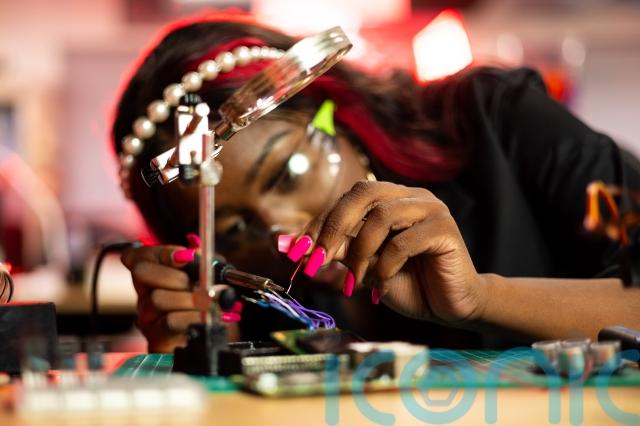
A woman who dreamed of becoming an engineer since the age of five has created high-tech nail extensions that link to webpages and clothing that connects to the weather forecast, inspiring the next generation and showing that tech can be “fun”.
Eneni Bambara-Abban, a 32-year-old robotics engineer and creative technologist, aspired to be an engineer after a walking doll “amazed” her and sparked a curiosity for dismantling household gadgets to understand how they worked.
Eneni, who lives in London, excelled in science throughout school, achieving all As in her GCSEs, but was rejected by the University of the West of England for a robotics engineering degree after not meeting the minimum entry requirements in her A-levels.
Still determined to achieve her childhood goal, she wrote a heartfelt letter to the dean and was offered a place on the foundation engineering course, which she began in 2012 before progressing to the degree the following year.
She said she was the only black woman on the course, leaving her feeling “isolated” and almost causing her to quit, until she was inspired by women she met at an engineering awards ceremony to keep going.
From there, she began exploring wearable technology, including how circuit boards could be embedded into nails and linked to a webpage – and which could, if regulations allowed, even be used to make payments.

Since graduating, she has shared her innovations online, founded The Techover Foundation, and begun developing smart clothing that can be scanned and linked to weather forecasts, showing young people – especially women – that engineering can be “creative”.
Eneni told PA Real Life: “I always thought ‘Why is tech so boring, so dry, why can’t it be fun?’.
“And back then, I was very obsessed with Japanese culture and I used to get nail extensions with designs of my favourite characters.
“Also, having undiagnosed ADHD back then, I was always forgetting things, so I constantly thought to myself ‘What if I had a way to put a chip inside me for my credit card, my room key, or my uni pass, that I would never lose?’.
“Then I came up with the idea of combining the two – semi-permanent nail extensions with a circuit embedded into them.”
Eneni had longed to be an engineer since she was five years old, inspired by a doll she saw at a flea market with her mother.
She said: “The doll was black, which in the ’90s was already quite rare… and then the guy showed my family it walking around and teetering along, I was just amazed.
“I can still remember it so vividly, like it was yesterday, I just was like ‘What kind of sorcery is this? How can I be a wizard?’.”

As she got older, Eneni became increasingly fascinated by engineering, taking apart kettles and other household objects to figure out how they worked.
During primary school, Eneni joined every science club she could, and she did “exceptionally well” in science-based subjects.
For secondary school, she moved to Nigeria, where she studied technical drawing, agriculture and science.
She later moved back to the UK, after achieving all As in her GCSEs, in 2010 for her A-levels. But she said she got “a bit distracted”, and achieved her first-ever B and C grades in her exams.
She was rejected from her first-choice university, the University of the West of England in Bristol, where she hoped to study robotic engineering.
Determined not to give up, she wrote a letter to the dean, explaining how long she had wanted to be a robotic engineer.
Eneni was then offered a place on the foundation engineering course.

She began the course in 2012, progressing to her degree in robotic engineering the following year.
However, she found day-to-day life “quite isolating”, as she said she was the only black woman on the course.
Because of this, she considered dropping out, until she attended an award ceremony at the Institution of Engineering and Technology, where she became inspired by the women she met.
From there, she began exploring ways of making engineering fun and much more appealing to other young women with hopes it would inspire more people to consider pursuing similar courses to her. One of those ways was through wearable technology.
After some brainstorming and consulting with electronics experts, she realised in theory that by leveraging NFC (near-field communication), she could be able to use a chip from a credit card, attach it to a nail, and that “hypothetically it might still work”.
So Eneni began working on circuit designs to repurpose NFC technology into wearable tech.
She explained: “The first initial prototypes were done on breadboards, which are reusable construction bases for building temporary electronic circuits without soldering – it looks like a rectangular board with loads of little holes on it.”

She then sent the designs to an electronics factory in China to make it miniature, by printing “very fine circuits onto thin flexible surfaces” which would be the perfect texture to integrate into acrylic nails because of being able to curve to the nail’s natural shape.
It is, Eneni said, “quite common with engineering” to outsource builds and work with a team – inventors rarely build the actual finished products alone.
It was also much cheaper to outsource – Eneni said it would have cost her “thousands”, but the factory could manufacture the same item for 30p a piece.
“The first completed nail extensions were press-ons with a range of my favourite designs that I knew young women would love – you scanned it and it would link to any webpage you wanted, you could even programme them to open up your Instagram,” she added.
She also linked it to a “dummy bank” with a “dummy bank card”, allowing it “hypothetically” to be used for payments.
For this, she would put the flexible chip – which worked in a similar way to smart rings and smart watches – on a nail bed, and then put the nail gel on top to “lock it in” and ensure it was not visible to others.
However, she soon realised that although technically feasible, it would not be practical in everyday life because of strict financial regulations as well as ethical concerns.
Eneni said: “I like to often recall a quote from one of the greatest franchises of all time – Spider-Man, of course – that says ‘with great power, comes great responsibility’. Even if I can do something as an engineer, it doesn’t mean I should…
“I won’t be fully connecting the circuit to (my actual bank account) or making it available publicly in the near future until the right safety and compliance protocols are met.”

She graduated in 2018 from her robotics degree, and now shares her projects on her Instagram page @thetechover – which has more than 6,000 followers.
Eneni also launched The Techover Foundation, aiming to inspire the next generation of Stem (science, technology, engineering and mathematics) students, particularly those from under-served backgrounds.
She has since visited schools across the world, from the UK to the Philippines and Nigeria, to show young people what engineering makes possible.
“I just feel like one of the major things deterring women from getting in and staying in engineering is imposter syndrome, and feeling like they’re alone or unseen due to it still, sadly, being a male-dominated industry,” Eneni said.
“But times are changing. I want to show that engineering is for everyone, regardless of gender.”
Looking ahead, Eneni continues to build upon the science of her nail-based technology, experimenting with additional materials such as conductive thread and clothing.
She said: “That’s essentially having the same kind of technology that was in my nails, but woven into your clothing.
“So you could scan your jumper with your phone, and your jumper could return an answer saying: ‘It’s too hot for me right now, find something else to wear’, or you scan an outfit’s tag and it tells you how far it came from, its materials and whether it was ethically made.”

To others who may not have considered a career in engineering, Eneni said: “Never stop asking questions, find your community … and even if you’re not good at maths in school, it doesn’t mean you can’t be an engineer!
“Don’t be afraid to fail – I think sometimes young people have such a pressure to choose what they’re going to do for the rest of their life, but I hope that my career shows that you can do anything and be anyone you want to be without following conventional routes, so long as you work hard and are passionate about it.”
For National Engineering Day, which took place on November 5, the Royal Academy of Engineering launched the AI-Z of Engineering to bring the definition of an engineer firmly into the present day and beyond.
Created with input from more than 100 engineers, the digital guide showcases the extraordinary breadth of modern engineering to inspire the next generation of engineers – those who will turn science fiction into fact and solve future challenges.
For more information, visit: www.thisisengineering.org.uk/ai-z-of-engineering.
Subscribe or register today to discover more from DonegalLive.ie
Buy the e-paper of the Donegal Democrat, Donegal People's Press, Donegal Post and Inish Times here for instant access to Donegal's premier news titles.
Keep up with the latest news from Donegal with our daily newsletter featuring the most important stories of the day delivered to your inbox every evening at 5pm.